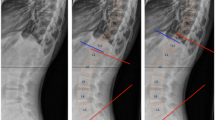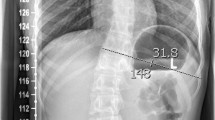Abstract
Background
Bracing constitutes the mainstay treatment for mild scoliosis. The 3D reconstruction of the spine using low-dose stereoradiographic imaging (LSI) is increasingly being used to determine the true shape of the deformity and to assess the success of bracing.
Objective
The aim of the study was to validate the measurement of 3D spinopelvic parameters and vertebral rotation in the setting of bracing treatment via a reliability study conducted in adherence to the guidelines for reporting reliability and agreement studies (GRRAS).
Material and methods
Full spine stereoradiographs of patients with adolescent idiopathic scoliosis (AIS) who underwent Chêneau bracing were retrospectively analyzed. The 3D reconstruction was performed by two experienced operators in a blinded manner and randomized order. Rotation of every vertebra was computed in the coronal, sagittal and axial planes. Sagittal spinopelvic parameters were evaluated. All measurements were statistically compared to determine agreement of the measurement of brace correction using the intraclass correlation coefficient (ICC).
Results
In this study, 45 patients (81% females) aged 12.5 ± 2 years were included. The mean absolute difference was less than 3.5° for all measured angles, less than 4 mm for sagittal vertical axis (SVA) and less than 1.5 mm for lateral pelvic shift. The ICC was high for all parameters (ICC >0.81). Despite the overall high reliability, the reliability of axial rotation was lower in the upper and middle thoracic spine and the lower lumbar spine.
Conclusion
Brace wearing during full spine LSI acquisition does not affect spinal measurements. The LSI under bracing treatment produces reliable measurements of spinopelvic parameters as well as vertebral rotation. These reproducible 3D data enable spine surgeons to assess the true shape of the deformity, to quantify rotation of each vertebra and enhance the understanding of the efficacy of bracing treatment.
Zusammenfassung
Hintergrund
Die Korsetttherapie ist die Behandlung für milde idiopathische Skoliosen (AIS). Die 3‑D-Rekonstruktion der Wirbelsäule mithilfe der LSI („low-dose stereoradiographic imaging“) wird zunehmend verwendet, um die tatsächliche Form und das Ausmaß der Deformität zu bestimmen und den Erfolg der Korsetttherapie zu bewerten.
Fragestellung
Die Interraterreliabilität der Wirbelsäulen-3-D-Messungen wurde im Rahmen der Korsetttherapie bei Patienten mit AIS bestimmt. Diese Studie wurde in Anlehnung an die GRRAS (Guidelines for Reporting Reliability and Agreement Studies) durchgeführt.
Material und Methoden
Röntgen-Wirbelsäulenganzaufnahmen (EOS) von 45 AIS-Patienten, die einer Therapie mittels Chêneau-Korsett unterzogen wurden, konnten retrospektiv analysiert werden. 3‑D-Rekonstruktionen wurden durch 2 erfahrene Untersucher erstellt. Beide Untersucher waren in Bezug auf die Patientendaten verblindet, und die Messungen wurden in randomisierter Form durchgeführt. Die Rotation aller Wirbelkörper wurde in allen Ebenen (koronar, sagittal, axial) ermittelt. Die Parameter des sagittalen Profils und die spinopelvinen Parameter wurden gemessen. Alle Messungen wurden statistisch ausgewertet, um die Übereinstimmung (Interraterreliabilität und Reproduzierbarkeit) unter Anwendung des ICC zu bestimmen.
Ergebnisse
In diese Studie wurden 45 Patienten (81 % Frauen) im Alter von 12,5 ± 2 Jahren eingeschlossen. Die mittlere absolute Differenz betrug für alle gemessenen Winkel weniger als 3,5° und für SVA weniger als 4 mm und für den Beckenschiefstand weniger als 1,5 mm. Der ICC lag für alle Parameter hoch (ICC >0,81). Trotz der hohen Gesamt-Zuverlässigkeit war der ICC für die axiale Rotation in der oberen und mittleren Brustwirbelsäule sowie in der unteren Lendenwirbelsäule niedriger.
Schlussfolgerung
Das Korsett hat während der LSI-basierten Rekonstruktion der Wirbelsäule keinen negativen Einfluss auf die Messungen. Die LSI unter Korsetttherapie liefert zuverlässige Messungen der spinopelvinen Parameter sowie der Wirbelkörperrotation. Diese reproduzierbaren 3‑D-Daten ermöglichen es den Wirbelsäulenchirurgen, die tatsächliche Form der Deformität einzuschätzen, die Rotation jedes Wirbels zu quantifizieren und das Verständnis für die Effizienz der Korsettbehandlung zu verbessern.


Similar content being viewed by others
Abbreviations
- 3D:
-
Three-dimensional
- AIS:
-
Adolescent idiopathic scoliosis
- AVR:
-
Apical vertebral rotation
- CT:
-
Computed tomography
- GRRAS:
-
Guidelines for reporting reliability and agreement studies
- ICC:
-
Intraclass correlation coefficient
- LL:
-
Lumbar lordosis
- LSI:
-
Low-dose stereoradiographic imaging
- MRI:
-
Magnetic resonance imaging
- PI:
-
Pelvic incidence
- PT:
-
Pelvic tilt
- SOSORT:
-
International Scientific Society on Scoliosis Orthopedic and Rehabilitation Treatment
- SRS:
-
Scoliosis Research Society
- SS:
-
Sacral slope
- SSA:
-
Spinosacral angle
- SVA:
-
Sagittal vertical axis
- TK:
-
Thoracic kyphosis
- TP:
-
Transverse plane
References
Al-Aubaidi Z, Lebel D, Oudjhane K et al (2013) Three-dimensional imaging of the spine using the EOS system: is it reliable? A comparative study using computed tomography imaging. J Pediatr Orthop 22:409–412
Bagheri A, Liu X‑C, Tassone C et al (2018) Reliability of three-dimensional spinal modeling of patients with idiopathic scoliosis using EOS system. Spine Deform 6:207–212
Bone CM, Hsieh GH (2000) The risk of carcinogenesis from radiographs to pediatric orthopaedic patients. J Pediatr Orthop 20:251–254
Courvoisier A, Drevelle X, Dubousset J et al (2013) Transverse plane 3D analysis of mild scoliosis. Eur Spine J 22:2427–2432
Courvoisier A, Vialle R, Skalli W (2014) EOS 3D imaging: assessing the impact of brace treatment in adolescent idiopathic scoliosis AU—Courvoisier, Aurélien. Expert Rev Med Devices 11:1–3
Deschênes S, Charron G, Beaudoin G et al (2010) Diagnostic imaging of spinal deformities: reducing patients radiation dose with a new slot-scanning X‑ray imager. Spine (Phila Pa 1976) 35:989–994
Doody MM, Lonstein JE, Stovall M et al (2000) Breast cancer mortality after diagnostic radiography: findings from the US Scoliosis Cohort Study. Spine (Phila Pa 1976) 25:2052–2063
Dubousset J, Charpak G, Skalli W et al (2007) Système EOS: la radiographie de la tête aux pieds face et profil simultanés à très basses doses de radiations: Un nouveau regard pour l’orthopédie. Rev Chir Orthop Reparatrice Appar Mot 93:141–143
Dunn G (2004) Statistical Evaluation of Measurement Errors: Design and Analysis of Reliability Studies, 2nd ed. Arnold, London
Fang M‑Q, Wang C, Xiang G‑H et al (2015) Long-term effects of the Chêneau brace on coronal and sagittal alignment in adolescent idiopathic scoliosis. J Neurosurg Spine 23:505–509
Faria R, Mckenna C, Wade R et al (2013) The EOS 2D/3D X‑ray imaging system: a cost-effectiveness analysis quantifying the health benefits from reduced radiation exposure. Eur J Radiol 82:e342–e349
Ferrero E, Lafage R, Vira S et al (2017) Three-dimensional reconstruction using stereoradiography for evaluating adult spinal deformity: a reproducibility study. Eur Spine J 26:2112–2120
Gille O, Champain N, Benchikh-El-Fegoun A et al (2007) Reliability of 3D reconstruction of the spine of mild scoliotic patients. Spine (Phila Pa 1976) 32:568–573
Humbert L, De Guise JA, Aubert B et al (2009) 3D reconstruction of the spine from biplanar X‑rays using parametric models based on transversal and longitudinal inferences. Med Eng Phys 31:681–687
Ilharreborde B, Steffen JS, Nectoux E et al (2011) Angle measurement reproducibility using EOSthree-dimensional reconstructions in adolescent idiopathic scoliosis treated by posterior instrumentation. Spine (Phila Pa 1976) 36:E1306–E1313
Ilharreborde B, Ferrero E, Alison M et al (2016) EOS microdose protocol for the radiological follow-up of adolescent idiopathic scoliosis. Eur Spine J 25:526–531
Illés T, Tunyogi-Csapó M, Somoskeöy S (2011) Breakthrough in three-dimensional scoliosis diagnosis: significance of horizontal plane view and vertebra vectors. Eur Spine J 20:135–143
Kottner J, Audigé L, Brorson S et al (2011) Guidelines for reporting reliability and agreement studies (GRRAS) were proposed. Int J Nurs Stud 48:661–671
Labelle H, Aubin C‑E, Jackson R et al (2011) Seeing the spine in 3D: how will it change what we do? J Pediatr Orthop 31:S37–S45
Lafage R, Ferrero E, Henry JK et al (2015) Validation of a new computer-assisted tool to measure spino-pelvic parameters. Spine J 15:2493–2502
Landis JR, Koch GG (1977) The measurement of observer agreement for categorical data. Biometrics 33:159–174. https://doi.org/10.2307/2529310
Luo TD, Stans AA, Schueler BA et al (2015) Cumulative radiation exposure with EOS imaging compared with standard spine radiographs. Spine Deform 3:144–150
Mettler FA Jr, Bhargavan M, Faulkner K et al (2009) Radiologic and nuclear medicine studies in the United States and worldwide: frequency, radiation dose, and comparison with other radiation sources—1950–2007. Radiology 253:520–531
Morel B, Moueddeb S, Blondiaux E et al (2018) Dose, image quality and spine modeling assessment of biplanar EOS micro-dose radiographs for the follow-up of in-brace adolescent idiopathic scoliosis patients. Eur Spine J 27:1082–1088
Nault M‑L, Mac-Thiong J‑M, Roy-Beaudry M et al (2014) Three-dimensional spinal morphology can differentiate between progressive and nonprogressive patients with adolescent idiopathic scoliosis at the initial presentation: a prospective study. Spine (Phila Pa 1976) 39:E601
Negrini S, Hresko TM, O’brien JP et al (2015) Recommendations for research studies on treatment of idiopathic scoliosis: Consensus 2014 between SOSORT and SRS non-operative management committee. Scoliosis 10:8
Newton PO, Fujimori T, Doan J et al (2015) Defining the “three-dimensional sagittal plane” in thoracic adolescent idiopathic scoliosis. J Bone Joint Surg Am 97:1694–1701
Newton PO, Khandwala Y, Bartley CE et al (2016) New EOS imaging protocol allows a substantial reduction in radiation exposure for scoliosis patients. Spine Deform 4:138–144
Presciutti SM, Karukanda T, Lee M (2014) Management decisions for adolescent idiopathic scoliosis significantly affect patient radiation exposure. Spine J 14:1984–1990
Preston DL, Cullings H, Suyama A et al (2008) Solid cancer incidence in atomic bomb survivors exposed in utero or as young children. J Natl Cancer Inst 100:428–436
Rankin G, Stokes MJCR (1998) Reliability of assessment tools in rehabilitation: an illustration of appropriate statistical analyses. Clin Rehabil 12:187–199
Rehm J, Germann T, Akbar M et al (2017) 3D-modeling of the spine using EOS imaging system: Inter-reader reproducibility and reliability. PLoS ONE 12:e171258
Rigo M, Weiss H (2008) The Chêneau concept of bracing-biomechanical aspects. Stud Health Technol Inform 135:303
Ronckers CM, Land CE, Miller JS et al (2010) Cancer mortality among women frequently exposed to radiographic examinations for spinal disorders. Radiat Res 174:83–90
Rousseau M‑A, Laporte S, Chavary-Bernier E et al (2007) Reproducibility of measuring the shape and three-dimensional position of cervical vertebrae in upright position using the EOS stereoradiography system. Spine (Phila Pa 1976) 32:2569–2572
Sangole A, Aubin C‑E, Labelle H et al (2010) The central hip vertical axis: a reference axis for the Scoliosis Research Society three-dimensional classification of idiopathic scoliosis. Spine (Phila Pa 1976) 35:E530–E534
Seibert JA (2004) Tradeoffs between image quality and dose. Pediatr Radiol 34:S183–S195
Shoukri M (2003) Reliability for continuous scale measurements. In: Measures of interobserver agreement
Shrout PE, Fleiss JL (1979) Intraclass correlations: uses in assessing rater reliability. Psychol Bull 86:420
Somoskeöy S, Tunyogi-Csapó M, Bogyó C et al (2012) Accuracy and reliability of coronal and sagittal spinal curvature data based on patient-specific three-dimensional models created by the EOS 2D/3D imaging system. Spine J 12:1052–1059
Stokes IA (1994) Three-dimensional terminology of spinal deformity. A report presented to the Scoliosis Research Society by the Scoliosis Research Society Working Group on 3‑D terminology of spinal deformity. Spine (Phila Pa 1976) 19:236–248
Tabard-Fougère A, Bonnefoy A, Hanquinet S et al (2016) Validity and reliability of spine rasterstereography in patients with adolescent idiopathic scoliosis. Spine (Phila Pa 1976). https://doi.org/10.1097/BRS.0000000000001679
Funding
This study was supported by the Deutsche Arthrose-Hilfe (P398-A326).
Author information
Authors and Affiliations
Corresponding author
Ethics declarations
Conflict of interest
H. Almansour, W. Pepke, J. Rehm, T. Bruckner, D. Spira and M. Akbar declare that they have no competing interests.
This article does not contain any experiments conducted on humans or animals. Institutional review board approval was provided (Vote no. S‑378).
Rights and permissions
About this article
Cite this article
Almansour, H., Pepke, W., Rehm, J. et al. Interrater reliability of three-dimensional reconstruction of the spine. Orthopäde 49, 350–358 (2020). https://doi.org/10.1007/s00132-019-03712-x
Published:
Issue Date:
DOI: https://doi.org/10.1007/s00132-019-03712-x




